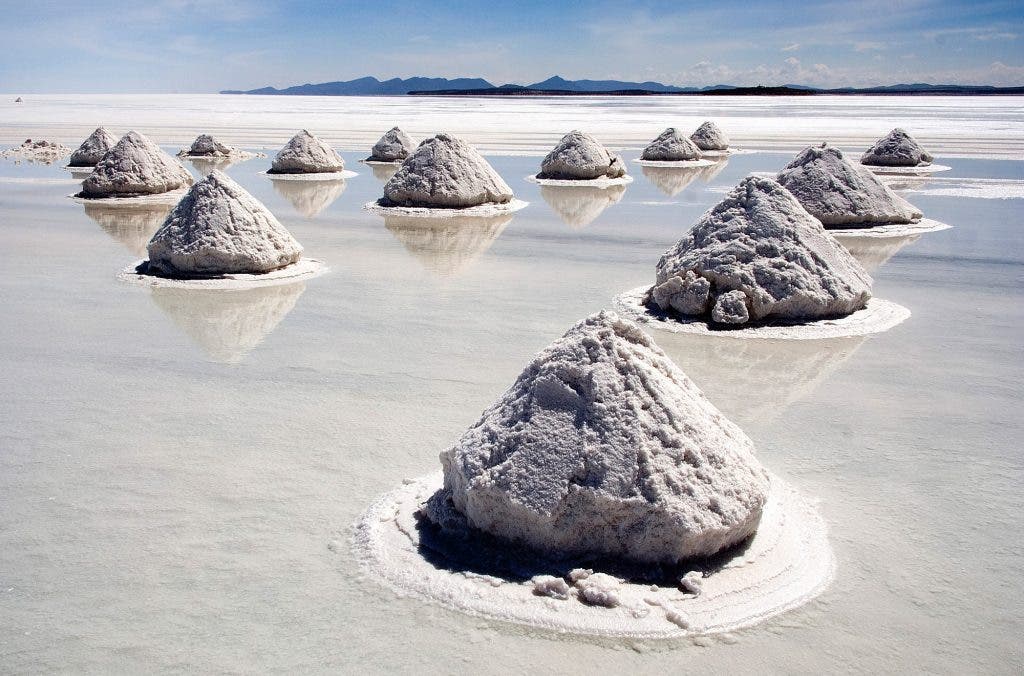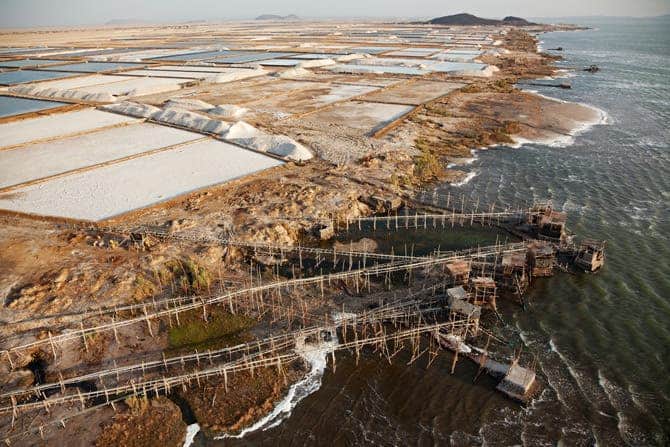Salt is one of the most common and yet most controversial substances on Earth. You can’t really live without it, but too much of it might kill you. It used to be very expensive, now it’s really cheap, and most of it is used for industrial purposes. It’s in the foods we eat, in the planetary oceans, and in us… but where does it come from?

What is salt
Salt is actually a mineral that comprises sodium and chloride (NaCl). In its natural form, it’s called rock salt or halite. In its most familiar form, salt is a white crystalline substance that is soluble in water. There are actually multiple types of salts — calcium chloride or copper sulfate are just to examples. We just call this one “salt” because it’s by far the most widely used one.
The history of salt intertwines with the development of civilizations due to its value in food preservation before refrigeration. Ancient trade routes were heavily influenced by salt. The Via Salaria, an essential Roman road, was originally a path for transporting salt. Similarly, across the globe, the Sahara Desert saw caravans traversing what would famously be known as “salt roads,” trading gold from sub-Saharan Africa for the precious “white gold.”
Industrially, salt plays an important role vast array of products, from the manufacturing of chlorine and caustic soda to the production of plastics and textiles. Biologically, salt is essential for the proper functioning of cells and the nervous system.
Salt is extremely important for the alimentation of all mammals, including humans. Not having enough sodium in your blood can lead to a number of negative symptoms, including headaches, dizziness, and even heart problems. This is unlikely to be a problem in the modern world, but was quite a challenge in the past.
This is why salt has been a prized possession since before the Antiquity.
Salt extraction in history
The first evidence of extracting salt (by boiling spring water) comes from Romania, and there is evidence of a saltworks in China in about the same period. It was highly valued by the Chinese and Arabs, as well as the Romans and Greeks.
Roman soldiers were actually sometimes paid in salt — this is where the word ‘salary’ comes from. For the Romans, which had a large empire, ensuring salt distribution throughout the land was essential. Salt deposits were cherished and defended fiercely.
For the coastal countries, the resource was accessible by boiling the oceanic water — open ocean has about 35 grams (1.2 oz) of solids per litre, a salinity of 3.5%. But for continental countries, salt is a scarce commodity. Civilizations fought wars over salt, as strange as that may sound now. It was a rare and highly valued resource.

But today, we don’t value salt almost at all! We just eat it, without giving it much thought… but where does out salt come from?
How is salt extracted
The methods of extracting salt in ancient times were as diverse as the cultures that valued it. One of the oldest methods, still in use today, is solar evaporation. This process involves allowing seawater to flow into shallow ponds, where the sun and wind evaporate the water, leaving behind salt crystals. This technique is still used in places like the picturesque salt pans scattered around the Mediterranean, which have been in operation since the Roman era.

The major source of salt today is seawater – seawater is basically an inexhaustible sourface of salt. There are two main techniques to extracting salt from seawater, and you can also mine salt from the depths of the Earth. The main ways of obtaining salt are:
- solution mining; in solution mining, you erect walls over salt beds. Then, you inject fresh water to dissolve the salt. The salt solution is then pumped out and taken to a special plant for evaporation – most of the salt we eat is actually produced this say.
- solar evaporation; this is the simpler, more old-school way of obtaining salt. You just leave the evaporation part to wind and the Sun, leaving the salt behind. Salt evaporation ponds are filled from the ocean and salt crystals can be harvested as the water dries up. It is usually harvested once a year when the salt reaches a specific thickness. This only works in areas with a specific climate (high temperatures and low precipitations), like in the Mediterranean area.
- deep shaft mining; you basically mine salt just like any other mineral. Salt exists as deposits in ancient underground sea beds, and you can mine and then process the rock salt.
- manual collection; in some areas, there is so much salt at the bottom of a lake or sea, that you can collect it manually.
Modern salt extraction
Fast forward to today, and the extraction of salt has become more sophisticated. The most common modern method is vacuum evaporation, which involves pumping water into underground salt beds to create brine. This brine is then brought to the surface and heated in vacuum pans to rapidly evaporate the water, leaving behind pure salt. This method is efficient and allows for the production of salt with specific grain sizes and purity levels.
Sustainability in salt extraction has also become a focus. Efforts are being made to reduce the environmental impact of salt production, such as minimizing land use and water consumption and managing the biodiversity of surrounding areas.
The types of salt
There’s also more than just one type of salt. For instance, Himalayan pink salt, mined from ancient sea beds in Pakistan, is known for its pink color due to trace minerals. It’s often used in cooking and as a decorative element in kitchens.
Sea salt, harvested through the evaporation of seawater, is also a bit different than the salt mined from the earth. It retains trace minerals and elements, giving it a more complex flavor profile compared to table salt. It’s a favorite among chefs for finishing dishes.
Iodized salt was introduced in the early 20th century. As the name implies, it is table salt mixed with a minute amount of iodine. This type of salt is useful because it prevents iodine deficiency in regions where the natural iodine content in food is low.
Salt today
Salt is more than just a flavor enhancer; it’s essential for human health. It helps regulate fluid balance and blood pressure in the body. However, its health impacts are a double-edged sword. While a certain amount of salt is necessary for bodily functions, excessive consumption can lead to health issues like hypertension and heart disease. This has led to dietary guidelines recommending moderation in salt intake.
In terms of which countries produce the most salt, China once again takes the crown, followed by India, Canada and Germany.

Interestingly enough though, we eat only 6% of the salt we produce, globally. Out of the rest, 12% is used in water conditioning processes, 8% goes for de-icing highways and 6% is used in agriculture. The rest (68%) is used for manufacturing and other industrial processes. PVC, plastics and paper pulp are all obtained with the use of salt.
From ancient grains to modern tables, the journey of salt is a testament to its enduring legacy and versatility. As we’ve explored, its extraction has evolved from simple pans and mines to sophisticated vacuum evaporation methods, mirroring humanity’s own technological progress. Salt’s story is not just about a condiment or a mineral; it’s about how a seemingly ordinary substance has been a constant, vital presence throughout human history, impacting our diets, economies, and industries. As we sprinkle salt on our next meal, let’s take a moment to appreciate this remarkable journey, from the depths of ancient oceans to our modern-day lives.


